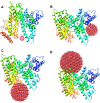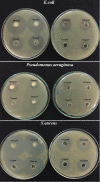Exploring the Interaction of Cobalt Oxide Nanoparticles with Albumin, Leukemia Cancer Cells and Pathogenic Bacteria by Multispectroscopic, Docking, Cellular and Antibacterial Approaches
- PMID: 32636621
- PMCID: PMC7328876
- DOI: 10.2147/IJN.S257711
Exploring the Interaction of Cobalt Oxide Nanoparticles with Albumin, Leukemia Cancer Cells and Pathogenic Bacteria by Multispectroscopic, Docking, Cellular and Antibacterial Approaches
Abstract
Aim: The interaction of NPs with biological systems may reveal useful details about their pharmacodynamic, anticancer and antibacterial effects.
Methods: Herein, the interaction of as-synthesized Co3O4 NPs with HSA was explored by different kinds of fluorescence and CD spectroscopic methods, as well as molecular docking studies. Also, the anticancer effect of Co3O4 NPs against leukemia K562 cells was investigated by MTT, LDH, caspase, real-time PCR, ROS, cell cycle, and apoptosis assays. Afterwards, the antibacterial effects of Co3O4 NPs against three pathogenic bacteria were disclosed by antibacterial assays.
Results: Different characterization methods such as TEM, DLS, zeta potential and XRD studies proved that fabricated Co3O4 NPs by sol-gel method have a diameter of around 50 nm, hydrodynamic radius of 177 nm with a charge distribution of -33.04 mV and a well-defined crystalline phase. Intrinsic, extrinsic, and synchronous fluorescence as well as CD studies, respectively, showed that the HSA undergoes some fluorescence quenching, minor conformational changes, microenvironmental changes as well as no structural changes in the secondary structure, after interaction with Co3O4 NPs. Molecular docking results also verified that the spherical clusters with a dimension of 1.5 nm exhibit the most binding energy with HSA molecules. Anticancer assays demonstrated that Co3O4 NPs can selectively lead to the reduction of K562 cell viability through the cell membrane damage, activation of caspase-9, -8 and -3, elevation of Bax/Bcl-2 mRNA ratio, ROS production, cell cycle arrest, and apoptosis. Finally, antibacterial assays disclosed that Co3O4 NPs can stimulate a promising antibacterial effect against pathogenic bacteria.
Conclusion: In general, these observations can provide useful information for the early stages of nanomaterial applications in therapeutic platforms.
Keywords: antibacterial; anticancer; cobalt oxide; docking; nanoparticle; spectroscopy; synthesis.
© 2020 Arsalan et al.
Conflict of interest statement
The authors report no conflicts of interest in this work.
Figures










Similar articles
-
Albumin binding, anticancer and antibacterial properties of synthesized zero valent iron nanoparticles.Int J Nanomedicine. 2018 Dec 28;14:243-256. doi: 10.2147/IJN.S188497. eCollection 2019. Int J Nanomedicine. 2018. PMID: 30643404 Free PMC article.
-
In vitro evaluation of anticancer and antibacterial activities of cobalt oxide nanoparticles.J Biol Inorg Chem. 2015 Dec;20(8):1319-26. doi: 10.1007/s00775-015-1310-2. Epub 2015 Nov 12. J Biol Inorg Chem. 2015. PMID: 26563952
-
Cobalt oxide nanoparticles mediate tau denaturation and cytotoxicity against PC-12 cell line.Int J Biol Macromol. 2018 Oct 15;118(Pt B):1763-1772. doi: 10.1016/j.ijbiomac.2018.07.024. Epub 2018 Jul 11. Int J Biol Macromol. 2018. PMID: 30017981
-
A comprehensive review of Co3O4 nanostructures in cancer: Synthesis, characterization, reactive oxygen species mechanisms, and therapeutic applications.Biomed Pharmacother. 2024 Nov;180:117457. doi: 10.1016/j.biopha.2024.117457. Epub 2024 Sep 20. Biomed Pharmacother. 2024. PMID: 39305816 Review.
-
Antibacterial Metal Oxide Nanoparticles: Challenges in Interpreting the Literature.Curr Pharm Des. 2018;24(8):896-903. doi: 10.2174/1381612824666180219130659. Curr Pharm Des. 2018. PMID: 29468956 Free PMC article. Review.
Cited by
-
Molecular mechanism of enhancing antitumor activity through the interaction between monosaccharides and human serum albumin.Anal Bioanal Chem. 2025 Jan;417(2):251-263. doi: 10.1007/s00216-024-05665-3. Epub 2024 Nov 22. Anal Bioanal Chem. 2025. PMID: 39576312
-
Inspirations of Cobalt Oxide Nanoparticle Based Anticancer Therapeutics.Pharmaceutics. 2021 Oct 2;13(10):1599. doi: 10.3390/pharmaceutics13101599. Pharmaceutics. 2021. PMID: 34683892 Free PMC article. Review.
-
Transition metal-based nanoparticles as potential antimicrobial agents: recent advancements, mechanistic, challenges, and future prospects.Discov Nano. 2023 Jun 7;18(1):84. doi: 10.1186/s11671-023-03861-1. Discov Nano. 2023. PMID: 37382784 Free PMC article. Review.
-
Overcoming the Low-Stability Bottleneck in the Clinical Translation of Liposomal Pressurized Metered-Dose Inhalers: A Shell Stabilization Strategy Inspired by Biomineralization.Int J Mol Sci. 2024 Mar 13;25(6):3261. doi: 10.3390/ijms25063261. Int J Mol Sci. 2024. PMID: 38542235 Free PMC article. Review.
-
Nanofibers in Glioma Therapy: Advances, Applications, and Overcoming Challenges.Int J Nanomedicine. 2025 Apr 14;20:4677-4703. doi: 10.2147/IJN.S510363. eCollection 2025. Int J Nanomedicine. 2025. PMID: 40255668 Free PMC article. Review.
References
-
- Zabeo A, Keisler JM, Hristozov D, Marcomini A, Linkov I. Value of information analysis for assessing risks and benefits of nanotechnology innovation. Environ Sci Eur. 2019;31(1):11. doi:10.1186/s12302-019-0194-0 - DOI
-
- Larsson S, Jansson M, Boholm Å. Expert stakeholders’ perception of nanotechnology: risk, benefit, knowledge, and regulation. J Nanopart Res. 2019;21(3):57. doi:10.1007/s11051-019-4498-1 - DOI
-
- Morales AAA, Nielsen J, Gomes ER, Rasmusen LB, Bacarini H, Thomsen B. Some insights into nanotechnology innovation processes and patterns for advanced materials. Contaduría y administración. 2019;64(1):11.
-
- Zhang H, Tian Y, Jiang L. Fundamental studies and practical applications of bio-inspired smart solid-state nanopores and nanochannels. Nano Today. 2016;11(1):61–81. doi:10.1016/j.nantod.2015.11.001 - DOI
MeSH terms
Substances
LinkOut - more resources
Full Text Sources
Medical
Research Materials

